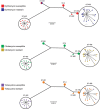Population structure and antimicrobial resistance of invasive serotype IV group B Streptococcus, Toronto, Ontario, Canada
- PMID: 25811284
- PMCID: PMC4378482
- DOI: 10.3201/eid2014.140759
Population structure and antimicrobial resistance of invasive serotype IV group B Streptococcus, Toronto, Ontario, Canada
Erratum in
- Emerg Infect Dis. 2015 Aug;21(8):1489
Abstract
We recently showed that 37/600 (6.2%) invasive infections with group B Streptococcus (GBS) in Toronto, Ontario, Canada, were caused by serotype IV strains. We report a relatively high level of genetic diversity in 37 invasive strains of this emerging GBS serotype. Multilocus sequence typing identified 6 sequence types (STs) that belonged to 3 clonal complexes. Most isolates were ST-459 (19/37, 51%) and ST-452 (11/37, 30%), but we also identified ST-291, ST-3, ST-196, and a novel ST-682. We detected further diversity by performing whole-genome single-nucleotide polymorphism analysis and found evidence of recombination events contributing to variation in some serotype IV GBS strains. We also evaluated antimicrobial drug resistance and found that ST-459 strains were resistant to clindamycin and erythromycin, whereas strains of other STs were, for the most part, susceptible to these antimicrobial drugs.
Keywords: Canada; Streptococcus agalactiae; Toronto; antimicrobial resistance; bacteria; bacterial infection; group B Streptococcus; invasive bacterial disease; multilocus sequence typing; population structure; serotype IV; streptococci; whole-genome sequencing.
Figures


Similar articles
-
Emergence of Serotype IV Group B Streptococcus Adult Invasive Disease in Manitoba and Saskatchewan, Canada, Is Driven by Clonal Sequence Type 459 Strains.J Clin Microbiol. 2015 Sep;53(9):2919-26. doi: 10.1128/JCM.01128-15. Epub 2015 Jul 1. J Clin Microbiol. 2015. PMID: 26135871 Free PMC article.
-
Serotype Distribution, Population Structure, and Antimicrobial Resistance of Group B Streptococcus Strains Recovered from Colonized Pregnant Women.J Clin Microbiol. 2017 Feb;55(2):412-422. doi: 10.1128/JCM.01615-16. Epub 2016 Nov 16. J Clin Microbiol. 2017. PMID: 27852675 Free PMC article.
-
Genetic Diversity and Antimicrobial Drug Resistance of Serotype VI Group B Streptococcus, Canada.Emerg Infect Dis. 2018 Oct;24(10):1941-1942. doi: 10.3201/eid2410.171711. Emerg Infect Dis. 2018. PMID: 30226176 Free PMC article.
-
One hypervirulent clone, sequence type 283, accounts for a large proportion of invasive Streptococcus agalactiae isolated from humans and diseased tilapia in Southeast Asia.PLoS Negl Trop Dis. 2019 Jun 27;13(6):e0007421. doi: 10.1371/journal.pntd.0007421. eCollection 2019 Jun. PLoS Negl Trop Dis. 2019. PMID: 31246981 Free PMC article.
-
Perinatal Streptococcus agalactiae Epidemiology and Surveillance Targets.Clin Microbiol Rev. 2018 Aug 15;31(4):e00049-18. doi: 10.1128/CMR.00049-18. Print 2018 Oct. Clin Microbiol Rev. 2018. PMID: 30111577 Free PMC article. Review.
Cited by
-
Fluoroquinolone Resistance among Clonal Complex 1 Group B Streptococcus Strains.Can J Infect Dis Med Microbiol. 2016;2016:6403928. doi: 10.1155/2016/6403928. Epub 2016 Jul 31. Can J Infect Dis Med Microbiol. 2016. PMID: 27559344 Free PMC article.
-
Group B Streptococcus Sequence Type 283 Disease Linked to Consumption of Raw Fish, Singapore.Emerg Infect Dis. 2016 Nov;22(11):1974-1977. doi: 10.3201/eid2211.160252. Emerg Infect Dis. 2016. PMID: 27767905 Free PMC article.
-
Detecting viral genomes in the female urinary microbiome.J Gen Virol. 2018 Aug;99(8):1141-1146. doi: 10.1099/jgv.0.001097. Epub 2018 Jun 11. J Gen Virol. 2018. PMID: 29889019 Free PMC article.
-
Molecular epidemiology and virulence factors of group B Streptococcus in South Korea according to the invasiveness.BMC Infect Dis. 2024 Jul 26;24(1):740. doi: 10.1186/s12879-024-09625-1. BMC Infect Dis. 2024. PMID: 39060964 Free PMC article.
-
Population Genomics Reveals Distinct Temporal Association with the Emergence of ST1 Serotype V Group B Streptococcus and Macrolide Resistance in North America.Antimicrob Agents Chemother. 2022 Jan 18;66(1):e0071421. doi: 10.1128/AAC.00714-21. Epub 2021 Oct 11. Antimicrob Agents Chemother. 2022. PMID: 34633844 Free PMC article.
References
-
- Centers for Disease Control and Prevention. Active bacterial core surveillance report, Emerging Infections Program Network, group B Streptococcus, 2011. 2012 [cited 2014 Mar 26]. http://www.cdc.gov/abcs/reports-findings/survreports/gbs11.pdf
Publication types
MeSH terms
Substances
Grants and funding
LinkOut - more resources
Full Text Sources
Other Literature Sources
Medical

